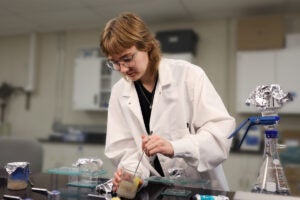AUSTIN, Texas —A colorful butterfly species found in tropical rainforests in Central and South America has evolved a remarkable method for overcoming cyanide producing compounds in passion vines, according to biologists at The University of Texas at Austin. The scientists believe their discovery has potential implications for the development of safer tropical food crops — which today are associated with chronic health problems.
The research will be published in the July 13 issue of the British scientific journal Nature.
The story of how one of the world’s deadliest poisons, the vine that produces the passion fruit, and one of the world’s most beautiful and varied butterfly species evolved together is one that scientists have not yet unraveled.
But research by Dr. Helene S. Engler, a lecturer at UT Austin’s School of Biological Sciences; Dr. Lawrence E. Gilbert, UT Austin professor of integrative biology; and Dr. Kevin C. Spencer, an independent researcher and expert in cyanogenic glycosides who lives in Wendover Dean, England, sheds new light on the mystery.
“Coming at it from a chemical perspective gives us a new view on the co-evolution between the butterfly and the host plant,” said Engler, lead author of the paper. “The Heliconius sarabutterfly has evolved a novel mechanism for metabolizing poison-producing compounds in the plant called cyanogenic glycosides — while at the same time avoiding the release of hydrogen cyanide. The butterfly larvae actually pull off the cyanide (CN) molecule from cyanogens stored in their bodies, potentially releasing nitrogen, a very important nutrient.”
The butterfly larvae consume passion vine leaves that produce the toxin and store the compound in their body, doing a chemical end run around the danger. In a mechanism not yet fully understood, they replace the CN molecule with an SH (sulfur hydrogen) molecule, Engler said. The insect never actually comes in contact with the toxin.
Engler said further research is needed to reveal the full significance of this mechanism for the nutrition of the butterflies themselves. She said more research also has the potential to lead to new methods for making vegetables and plants containing cyanogenic compounds safer and possibly more nutritious for humans and animals.
Long before chemists developed pesticides in the lab, many plants evolved their own natural insecticides to protect themselves from voracious insects. A cyanogenic glycoside is a cyanide-releasing compound that occurs naturally in more than 3,000 species of plants. The compounds are found in important food plants such as cassava, almonds, lima beans, sweet potatoes, yams, white clover and sorghum. Such plants make good food crops because they are relatively pest free.
Engler explained that cyanogenic compounds are inactive by themselves, but generally they are found with an enzyme that triggers their release. When a feeding caterpillar bites a passion vine leaf, it’s like setting off a tiny chemical bomb. The enzyme breaks down, joining the compound and releasing the poison, hydrogen cyanide.
Human beings have evolved their own enzymes to detoxify the foods, plus cooking methods to remove the toxins. These foods can be consumed safely as long as diet is varied or the food is eaten slowly. Unfortunately, neither the human enzymes nor the cooking methods are foolproof. A monotonous diet centered on such foods as cassava, a staple in Africa and Latin America, has been linked to several chronic health problems, including conditions that impair vision and attack the nervous system. Hence the scientific interest in developing safer crops and the Heliconius butterfly’s intriguing ability to thrive on cyanogenic passion vine leaves.
Engler’s work for the first time revealed the ability of the butterflies to sequester–or store–cyanogenic glycosides in their body tissue. But even more exciting was the discovery that the butterflies are, in fact, removing the dangerous cyanide molecule from their only food source.
“This is the first time scientists have demonstrated that an insect can metabolize cyanogenic glycosides in such a way that hydrogen cyanide is never released,” Engler said.
“The potential application this research may have in improving food crops is only one example of the value of the rainforest. Rainforests are storehouses of natural resources containing information which can benefit us in ways never imagined,” Engler said. “Let this be a reminder to the world of the crucial importance of protecting this rapidly disappearing resource and it’s diversity of life–including these marvelous butterflies.”
For more information, contact Dr. Helene Engler at (512) 471-8240 or e-mail h.engler@mail.utexas.edu. For images, contact Marsha Miller at the UT Austin Office of Public Affairs (512) 471-3151.



